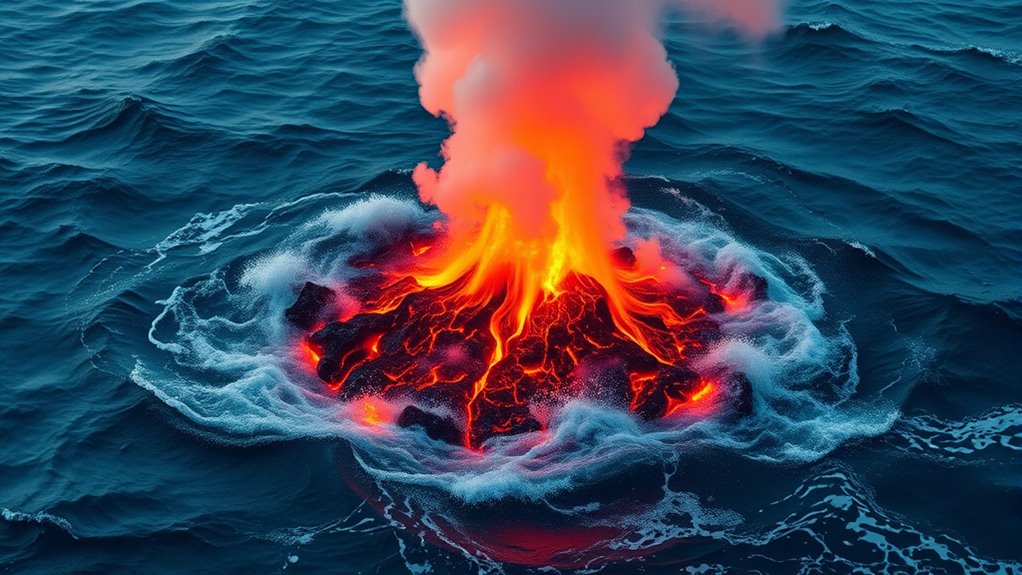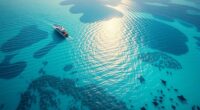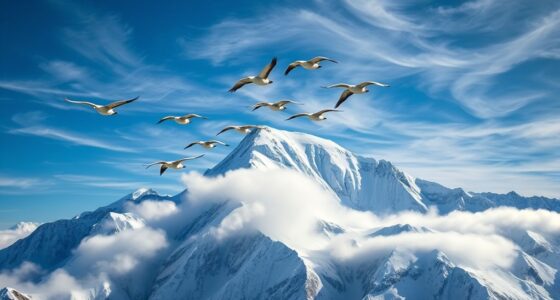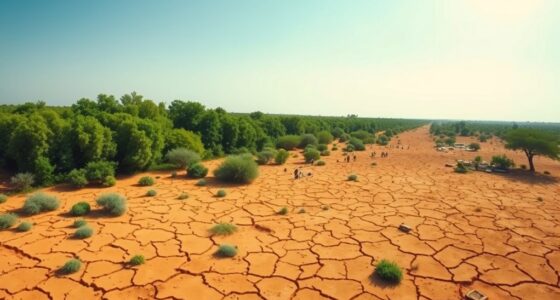When an undersea volcano erupts in the Pacific, it often creates a new island by piling up lava and ash above sea level. Scientists closely monitor these events to track seismic activity, gas emissions, and how the land forms and stabilizes over time. As the island cools, plants, animals, and insects start to colonize the area, shaping a new ecosystem. If you want to understand how these processes unfold and what they mean, keep exploring further details.
Key Takeaways
- An undersea volcano eruption in the Pacific has resulted in the formation of a new landmass above water.
- Continuous monitoring tracks seismic activity, gas emissions, and thermal changes to assess the island’s development.
- Initial colonizers include bacteria, algae, and hardy plants that survive extreme heat conditions.
- The island’s geological features and stability are studied to predict future volcanic activity and landmass lifespan.
- The formation offers insights into ecological resilience and how life re-establishes in extreme volcanic environments.
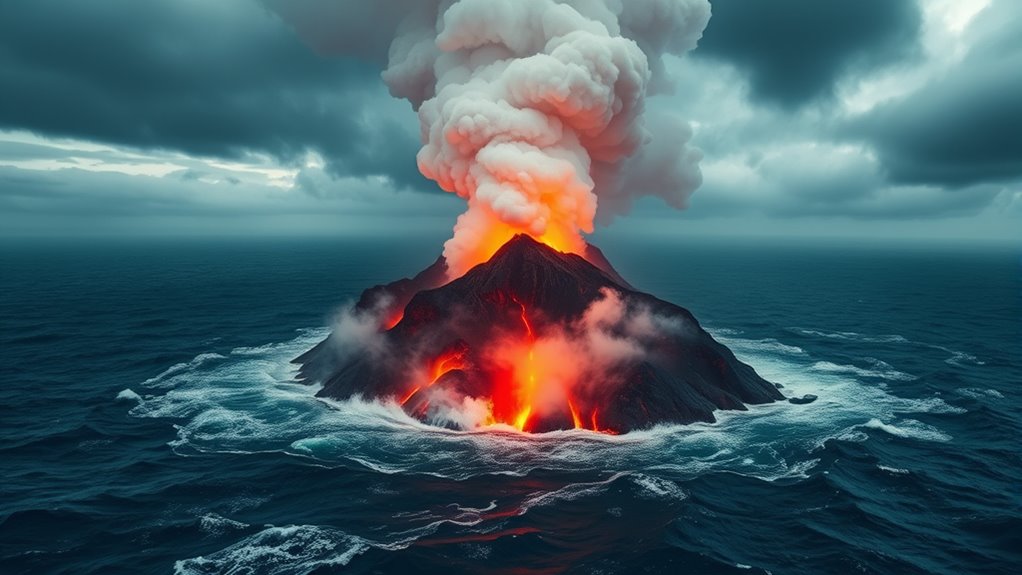
A powerful undersea volcano has erupted, giving birth to a brand new island in the middle of the ocean. The sudden explosion of molten lava and ash has created a landmass where there was once only open water. This rare event captures the attention of scientists and explorers alike, who immediately turn their focus to understanding what this new island means for the surrounding environment. As the island begins to form, volcano monitoring becomes essential. You need to keep a close eye on seismic activity, gas emissions, and thermal changes to guarantee the volcano remains active and safe. Continuous monitoring helps predict potential eruptions and provides insights into how the landmass is evolving. It’s a dynamic process, and staying vigilant is key to understanding the eruption’s progression and its long-term impact. Biodiversity recovery is a crucial aspect of ecological succession on new volcanic islands, as life gradually re-establishes itself in these extreme environments. Once the initial chaos settles, you start to observe the island’s emerging ecology. In the early days, life is sparse—tiny bacteria, algae, and hardy plants that can withstand extreme heat and harsh conditions begin to colonize the fresh lava. Over time, more complex ecosystems will develop, but it’s a slow process. You realize that studying how life re-establishes itself here will teach you about resilience and adaptation. The island ecology offers clues about how ecosystems recover after volcanic events, which can inform conservation efforts elsewhere. As the island cools and stabilizes, you’ll see birds, insects, and eventually small marine creatures establishing footholds along the coast. The way these species colonize the new land will be critical for understanding ecological succession and the potential for biodiversity growth in such a hostile environment. Your role involves tracking these changes meticulously. You collect data on soil composition, plant growth, and animal presence, all of which influence how the island’s ecology develops. The interplay between volcanic activity and ecological progress is complex; ongoing eruptions can reset the ecological clock, while stable periods allow ecosystems to take hold. This delicate balance highlights the importance of volcano monitoring—not just for safety, but for understanding the natural processes that turn raw lava into thriving habitats. Watching this transformation unfold, you realize that the island’s future depends on both geological activity and biological resilience. It’s a living experiment in how life can emerge from chaos, reminding you of nature’s extraordinary capacity to adapt and flourish against all odds. Furthermore, understanding the geological processes involved can help predict future volcanic activity and mitigate risks for nearby populations. Recognizing how volcanic landforms develop and evolve is essential for comprehensive risk assessment and long-term planning. Studying these processes also enhances our knowledge of volcanic landform evolution, which is vital for predicting future eruptions and landmass stability. Analyzing these geological features can provide invaluable insights into the stability and lifespan of newly formed islands.
Frequently Asked Questions
How Long Will the New Island Remain Above Sea Level?
You wonder how long the new island will stay above sea level. Its volcanic longevity depends on ongoing eruptions and lava build-up, but erosion rates from wind and waves will gradually wear it down. Typically, small volcanic islands may last a few years to decades before shrinking or disappearing, especially if erosion outpaces volcanic activity. Monitoring these factors can help predict how long you’ll see this new land above the water.
What Species Might Colonize the Newly Formed Island?
Imagine this island turning into a bustling paradise overnight! You might see hardy pioneer species like mosses and lichens quickly colonize it through volcanic succession. Over time, plants and insects will arrive, followed by birds and small mammals. However, watch out for invasive species that could disrupt this delicate balance. Your role is essential in understanding how ecosystems develop and the potential threats from invasive species that could hinder natural succession on this new land.
Can Eruptions Occur Again in the Same Area?
You might wonder if eruptions can happen again in the same area. Yes, volcanic activity and tectonic movement can cause eruptions to recur over time. When an eruption occurs, volcanic ash settles, but tectonic activity beneath the surface continues, potentially creating pressure for future eruptions. So, the area remains geologically active, and another eruption could happen, shaping the landscape further and impacting existing ecosystems.
How Does the Eruption Impact Local Marine Ecosystems?
Imagine snorkeling near a newly formed island, where vibrant marine life once thrived. The eruption temporarily disrupts marine ecosystems, causing pollution and affecting fish populations. You might notice increased marine pollution from ash and debris, which harms habitats. Local authorities may tighten fishing regulations to protect fragile species. While the area recovers, these measures help restore balance, ensuring you can enjoy the rich marine environment for years to come.
Will the Island Be Accessible for Tourism or Research?
You might wonder if the island will be accessible for tourism or research. Currently, volcano monitoring helps assess eruption activity and potential hazards, which influences island accessibility. If monitoring indicates safety, researchers and tourists could visit the island, but access might be limited initially due to ongoing volcanic activity. As conditions stabilize, the island could become a site for scientific studies and eco-tourism, offering exciting opportunities for exploration.
Conclusion
You might imagine yourself witnessing this incredible event, just like the 2013 eruptions near Nishinoshima, Japan, which formed a new island. These eruptions remind you how powerful underwater volcanoes are, constantly shaping our planet’s surface. As new islands emerge, they become essential habitats and fascinating destinations for explorers. So, stay curious—each eruption could create the next landmass that changes our world and offers new opportunities for discovery.
